Theory & Context Seminar | MRAC 2018-2019
Faculty: Ricardo Devesa
Student: Omar Geneidy
Incorporating A Simultaneous Layer Stapling Process While 3D Printing Structures So As To Complement Their Structural Properties
Abstract
Three Dimensional Printing (3DP) has been introduced into the construction industry for over two decades until now, However, the scaling up of the technology is currently stagnant due to some difficulties like printing horizontal or cantilever structures and printing structures over one floor heigh. The literature encompasses several attempts to overcome such limitations either by printing supporting structures that holds up the printed structure until it dries, or by casting it in a formwork that encapsulates a printed reinforcement inside it. Or, by manually adding reinforcement while printing. However, these attempts do not tackle the issue of having a unified printing process that includes vertical reinforcement in it. This research is proposing a new process of stapling clay with wire profiles simultaneously while printing in a periodical manner. Forming an interlocking wire structure that binds the printed layers together and compliments the overall structural soundness of the clay. The process is later tested against different properties so as to asses its validity compared to current procedures.
Research question
Will the simultaneous stapling of wire profiles into printed layers during clay or concrete printing improve their structural properties by achieving a more robust layer to layer connection ?

Keywords
3D Printing, Reinforcement, Layer Stapling
1.0 Introduction
Three-dimensional printing (3DP) is taking over the construction industry swiftly, with materials like concrete and clay being used to print large structures. The technology comes in handy as a replacement of the traditionally followed methods in construction; as it is more accurate, faster, less labor-intensive and offers the ability to realize more complex geometries. However, the scaling up of the technology is currently stagnant due to difficulties present in printing horizontal or cantilever structures and printing structures over one floor heigh. In an attempt to overcome such constrain, reinforcement was added manually while printing. In other cases, reinforcement was pre-printed and concrete was later cast using from works into the printed plastic mesh. However, this does not tackle the issue of reinforcing printed structures at the same time they are being printed.
This Research will be exploring a new process of stapling printed layers with wire profiles simultaneously while printing so as to maintain a sturdy layer to layer connection which shall addd to the overall structural soundness of the printed layers.
This research will follow an experimental approach of printing different samples of clay while reinforcing them using the proposed method. These samples will later be tested against different properties (ex. compressive strength and stress ) so as to asses the validity of the process.
1.1 Technical obstacles hindering the scale up of 3DP in Construction
The introduction of digital fabrication technology has the potential of enabling architects to design and produce in a new way, escaping from the existing current standardized modular system (Ko et al. 2019). 3DP has been introduced into the construction scale for over two decades until now, yet there are major obstacles that are yet to be solved (Alothman et al., n.d.). In order to have the desired smooth surface, the layer height needs to be small, which increases fabrication time. Moreover, the hydration process of the printed material is difficult to control and has an affect on the structure’s load-bearing capacity and the layer to layer adhesion (Hack 2015). Taking clay as an example, clay takes some time to dry after extrusion which makes it very difficult to form a self-supporting structur
e. And in the case of decreasing the drying time, clay starts cracking which accordingly weakens the printed structure. This makes it difficult to print hanging shapes without a supporting structure to maintain the form of deposited clay until it is dried (Ko et al. 2019). This adds a design constrain of a maximum angle of inclination before the structure collapses (Gaudilli, Duballet, and Bouyssou 2019).For that Integration of reinforcement in the process is essential for scaling-up the technology in architectural practice and minimizing its current limitations (Battaglia, Miller, and Zivkovic 2018).
1.2 Status Quo of Reinforcing Digital Concrete
Once cured, concrete can take high forces of compression. However, it needs reinforcement in order to compensate for tensional forces (Hack 2015). Previous tests showed that laying steel wires over the printed mixture increases structural strength within the layer but does not address the layer-to-layer discontinuity, while inserting a secondary material while printing enhances layer to layer fusion (Battaglia, Miller, and Zivkovic 2018).
The literature encompasses several attempts to overcome the current limitations of digital concrete. Concrete Formwork, as an example, A project by AI Build, explored the addition of temporary structures, a formwork, that holds the casted concrete until it dries out. Allowing for the possibility of realizing curvatures and designs that are otherwise not achievable using conventional layer by layer methods.
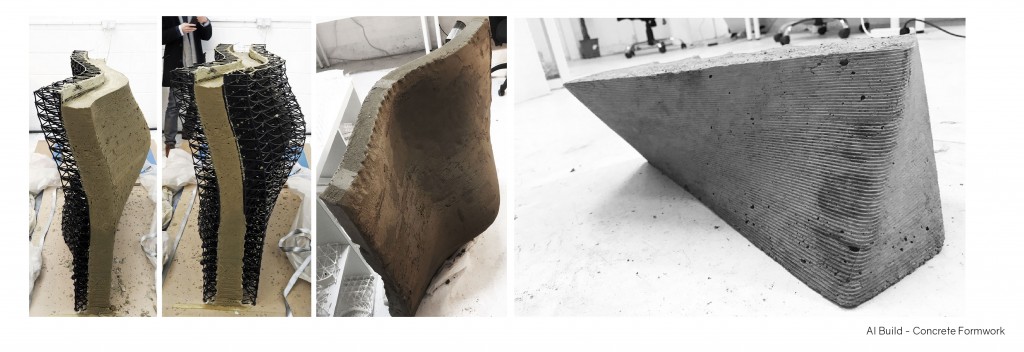
But, In that case, reinforcement supported the structure only during the drying face. However, doesn’t address the structural properties of the wall itself. Something which Gramazio Kohler tried to address. They followed a smilier path of casting the concrete using digitally fabricated fromworks, yet with the addition of a 3D printed lattice structure inside the formwork used as a reinforcement.

In a somehow similar fashion, Branch Technology were able to print structures for walls that were used to support walls and then coating it by a layer of concrete form the outside.

One last example is that of the Russian company’s Apic Cor 3D printed house. In this project small steel bars were laid down manually while printing as a kind of reinforcement to the printed structure.
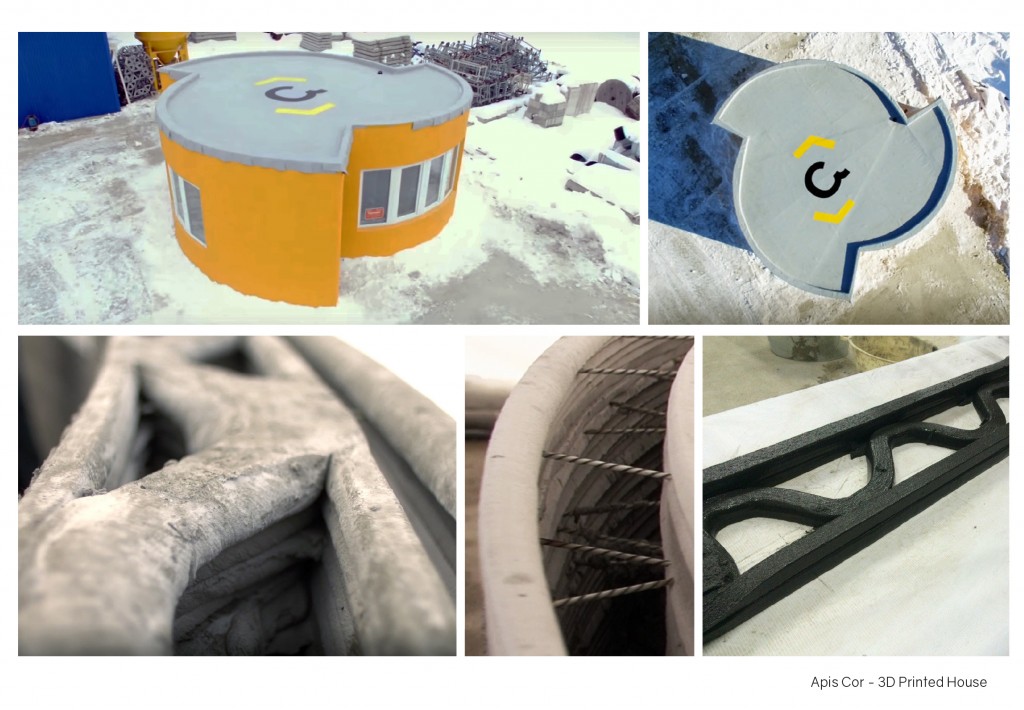
1.3 Status Quo of Digital Clay
Following a completely different approach, the researchers at IAAC’s OTF program pushed the limited of printing at an angle without adding a reinforcement by accounting for the center of gravity of the printed structure. The design of the infills between outer and the inner layers of the wall were altered to shift the position of the center of gravity by expanding or reducing the amount of material printed. As a result, they were successful in printing an arch without the need for reinforcement or temporary supporting structures.
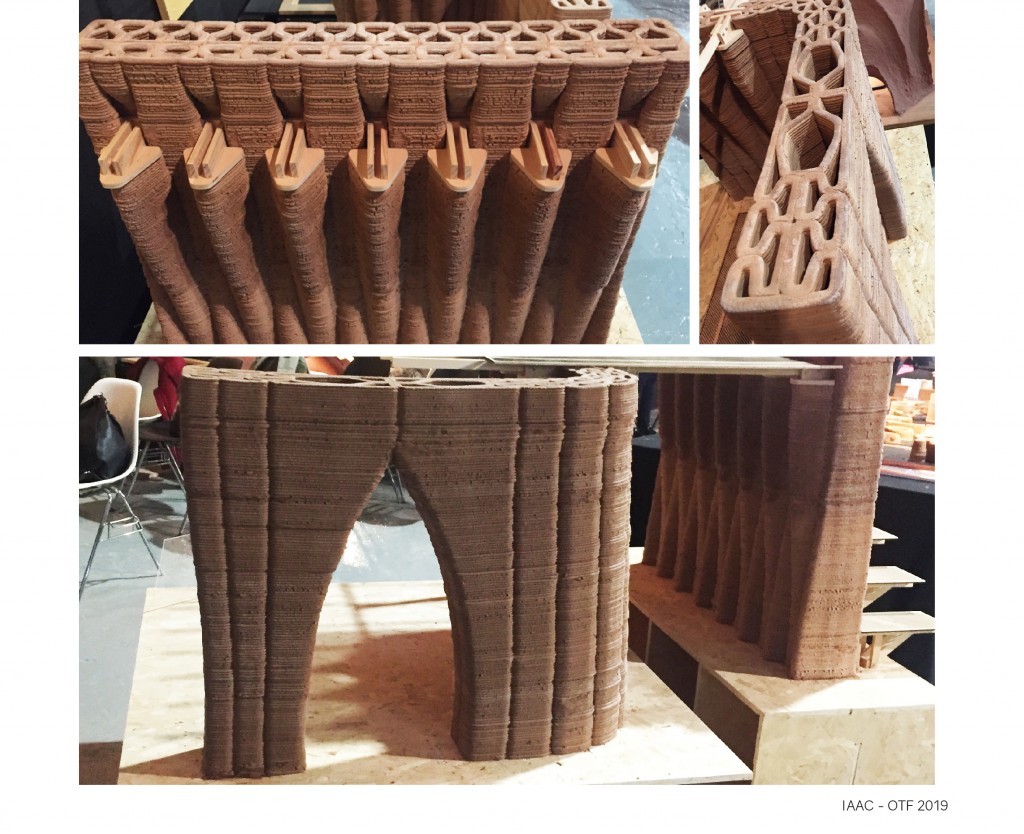
1.4 Layer Stapling Explained
The proposed process of clay stapling is composed of a tool head that includes a printing nozzle and a stapler. This stapler, pushes a wire profile in to the printed clay for a half a layer deep. The stapling process happens simultaneously while printing and in a periodical manner. Together these stapled profiles form an interlocking wire structure that fuses the printed layers together and compliments the overall structural soundness of the clay.
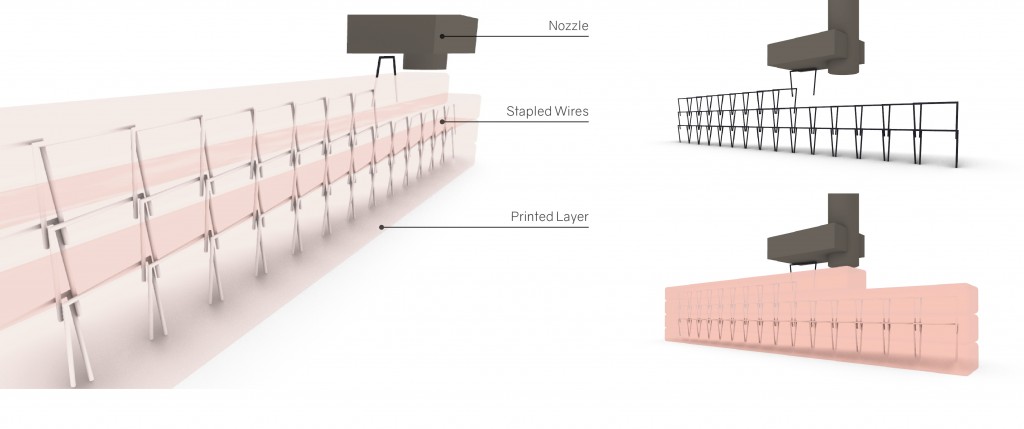
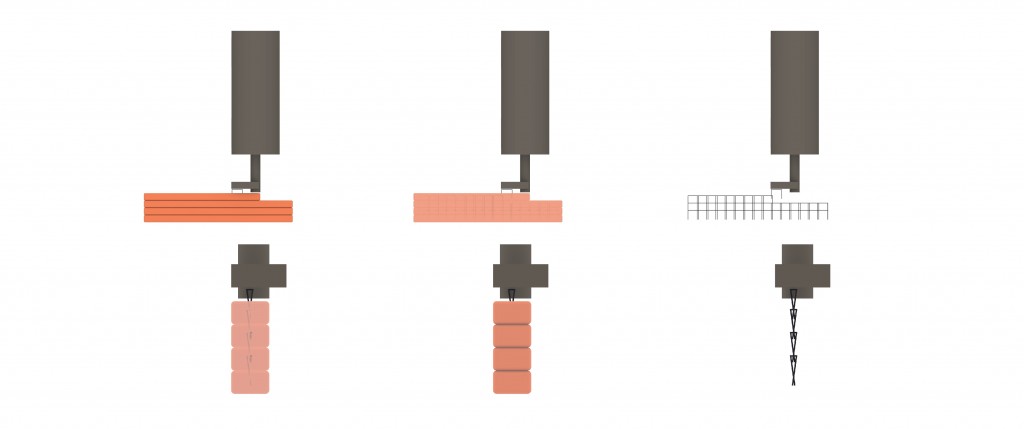
References
Aghaei Meibodi, Mania, Mathias Bernhard, Andrei Jipa, and Benjamin Dillenburger. 2017. “The Smart Takes from the Strong 3d Printing Stay-in-Place Formwork for Concrete Slab Construction.” In Fabricate 2014: Negotiating Design & Making, 210–17.
Alothman, Sulaiman, Hyeonji Claire Im, Francisco Jung, and Martin Bechthold. n.d. “Spatial Print Trajectory Controlling Material Behavior with Print Speed , Feed Rate , and Complex Print Path.” In .
Battaglia, Christopher A., Martin Fields Miller, and Sasa Zivkovic. 2018. “Sub-Additive 3D Printing of Optimized Double Curved Concrete Lattice Structures.” In Robotic Fabrication in Architecture, Art and Design 2018, 242–55. doi:10.1007/978-3-319-92294-2_19.
Bhooshan, Shajay, Johannes Ladinig, Tom Van Mele, and Philippe Block. 2019. “Function Representation for Robotic 3D Printed Concrete.” In Robotic Fabrication in Architecture, Art and Design 2018, 98–109. doi:10.1007/978-3-319-92294-2_8.
Dubor, Alexandre, Jean-Baptiste Izard, Edouard Cabay, Aldo Sollazzo, Areti Markopoulou, and Mariola Rodriguez. 2018. “On-Site Robotics for Sustainable Construction.” In Robotic Fabrication in Architecture, Art and Design 2018, 390–401. doi:10.1007/978-3-319-92294-2_30.
Friedman, Jared, Heamin Kim, and Olga Mesa. 2014. “Experiments in Additive Clay Depositions.” Robotic Fabrication in Architecture, Art and Design 2014, no. 2012: 261–73. doi:10.1007/978-3-319-04663-1.
Gardiner, James B, and Steven R Janssen. 2014. “Development of a Construction-Scale Robotic Formwork 3D Printer.” In Robotic Fabrication in Architecture, Art and Design 2014, 131–46. doi:10.1007/978-3-319-04663-1.
Gaudilli, Nadja, Romain Duballet, and Charles Bouyssou. 2019. “Large-Scale Additive Manufacturing of Ultra-High-Performance Concrete of Integrated Formwork for Truss-Shaped Pillars.” In Robotic Fabrication in Architecture, Art and Design 2018. Vol. 2.
GLYNN, RUAIRI, BOB SHEIL, and XAVIER DE KESTELIER. 2019. “Design Potential for Large-Scale Additive Fabrication.” In Fabricate 2011, 243–49. doi:10.2307/j.ctt1tp3c6d.45.
Hack, Norman. 2015. “Mesh Mould?: Robotically Fabricated Metal Meshes as Concrete Formwork and Reinforcement MESH MOULD?: ROBOTICALLY FABRICATED METAL MESHES AS.” In .
Huang, Yijiang, Josephine Carstensen, and Lavender Tessmer. 2019. “Robotic Extrusion of Architectural Structures with Nonstandard Topology.” In Robotic Fabrication in Architecture, Art and Design 2018.
Ko, Minjae, Donghan Shin, Hyunguk Ahn, and Hyungwoo Park. 2019. “InFormed Ceramics: Multi-Axis Clay 3D Printing on Freeform Molds.” In Robotic Fabrication in Architecture, Art and Design 2018, 297–308. doi:10.1007/978-3-319-92294-2_23.
Søndergaard, Asbjørn, Jelle Feringa, Florin Stan, and Dana Maier. 2019. “Realization of Topology Optimized Concrete Structures Using Robotic Abrasive Wire-Cutting of Expanded Polystyrene Formwork.” In Robotic Fabrication in Architecture, Art and Design 2018, 473–88. doi:10.1007/978-3-319-92294-2_36.
Yuan, Philip F, Hao Meng, Lei Yu, and Liming Zhang. 2016. “Robotic Multi-Dimensional Printing Based on Structural Performance.” In Robotic Fabrication in Architecture, Art and Design 2016. doi:10.1007/978-3-319-26378-6.